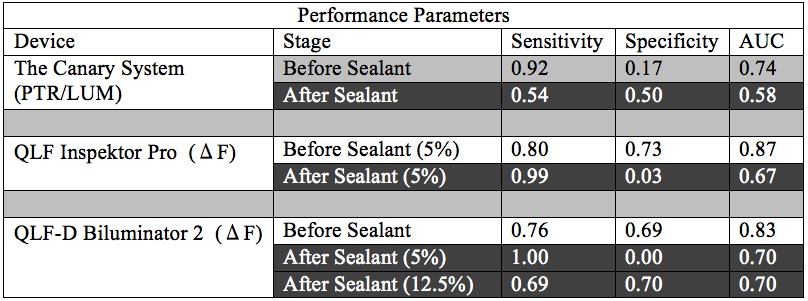IADR Abstract Archives
Occlusal Caries Detection Under Opaque Sealant With PTR/LUM and QLF
Objectives: Evaluate the performance Photothermal Radiometry and Modulated Luminescence, PTR/LUM, (the Canary System, Quantum Dental Technologies, Toronto, Canada), and two Quantitative Light-Induced Fluorescence devices; (QLF Inspektor Pro and QLF-D, Inspektor Research Systems B.V., Amsterdam, The Netherlands) on detection of occlusal primary caries under an opaque resin sealant in vitro by two examiners.
Methods: Extracted human posterior teeth (N=60) with fully formed roots and no frank cavitations or restorations were selected from a pool of teeth (IU-IRB # 1302010696). A single site was selected on each occlusal surface to represent ICDAS score “0” to “4”, then sealed with opaque resin sealant (Delton® Light-Curing Pit and Fissure Sealant Opaque, Dentsply, York, PA). Two calibrated examiners, guided by the white-light images, assessed the sites independently before and after the placement of the sealant twice with a 5-7 days interval between examinations. Histological validation was used to compare methods in regards to sensitivity, specificity and the area under receiver operating characteristic curve (AUC). Examiners agreement and repeatability were measured using Intraclass Correlation Coefficients (ICC). Classification trees using recursive partitioning methods were used to determine experimental cutoff points.
Results: Sensitivity, specificity and AUC values under the sealant were respectively: 0.54, 0.50 and 0.58 (The Canary System®); 0.99, 0.03 and 0.67 (Inspektor™ Pro); 1.00, 0.00 and 0.70 (QLF-D Biluminator™ 2 [5% ΔF]); and 0.69, 0.70 and 0.70 (QLF-D Biluminator™ 2 [12.5% ΔF]). Intra-examiner repeatability and inter-examiner agreement were respectively: 0.22-0.47: 0.01 (The Canary System®); 0.24-0.37: 0.29 (Inspektor™ Pro); and 0.80-0.84: 0.74 (QLF-D Biluminator™ 2).
Conclusions: None of the methods were able to reliably detect occlusal caries under the opaque sealant. However, QLF-D Biluminator™ 2, within the limitations of these in vitro conditions, demonstrated a fair accuracy AUC (0.70) in detecting of caries under sealants at an experimental threshold of 12.5% ΔF.
Methods: Extracted human posterior teeth (N=60) with fully formed roots and no frank cavitations or restorations were selected from a pool of teeth (IU-IRB # 1302010696). A single site was selected on each occlusal surface to represent ICDAS score “0” to “4”, then sealed with opaque resin sealant (Delton® Light-Curing Pit and Fissure Sealant Opaque, Dentsply, York, PA). Two calibrated examiners, guided by the white-light images, assessed the sites independently before and after the placement of the sealant twice with a 5-7 days interval between examinations. Histological validation was used to compare methods in regards to sensitivity, specificity and the area under receiver operating characteristic curve (AUC). Examiners agreement and repeatability were measured using Intraclass Correlation Coefficients (ICC). Classification trees using recursive partitioning methods were used to determine experimental cutoff points.
Results: Sensitivity, specificity and AUC values under the sealant were respectively: 0.54, 0.50 and 0.58 (The Canary System®); 0.99, 0.03 and 0.67 (Inspektor™ Pro); 1.00, 0.00 and 0.70 (QLF-D Biluminator™ 2 [5% ΔF]); and 0.69, 0.70 and 0.70 (QLF-D Biluminator™ 2 [12.5% ΔF]). Intra-examiner repeatability and inter-examiner agreement were respectively: 0.22-0.47: 0.01 (The Canary System®); 0.24-0.37: 0.29 (Inspektor™ Pro); and 0.80-0.84: 0.74 (QLF-D Biluminator™ 2).
Conclusions: None of the methods were able to reliably detect occlusal caries under the opaque sealant. However, QLF-D Biluminator™ 2, within the limitations of these in vitro conditions, demonstrated a fair accuracy AUC (0.70) in detecting of caries under sealants at an experimental threshold of 12.5% ΔF.


